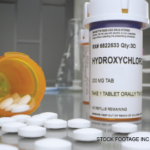For follow-up, automated visual fields and SD-OCT testing are recommended. The use of additional testing, including multifocal electroretinogram (mfERG) or fundus autofluorescence (FAF), is recommended when available at a patients’ eye care provider.13 SD-OCT generates images of the retina to the resolution level of cell layers. mfERG measures the electrical response to stimuli in order to identify damage. Fundus autofluorescence technology detects fluorescence that can be the consequence of damage.
Older forms of screening, including fundus photography, time-domain OCT, fluorescein angiography, full-field ERG, Amsler grid, color testing and electro-oculogram are not preferred because they are less sensitive and/or too subjective.
The first examination should occur at baseline (near, but not necessarily be prior to beginning therapy) and then, if no other risk factors are present, should be repeated after five years and annually thereafter. If additional risk factors are identified, then screening should occur annually.14
Although this specifically refers to screening in the asymptomatic setting, if a patient experiences vision changes including color vision then the patient should be referred to their eye care provider.
Managing Retinal Toxicity
The presence of damage necessitates discussion of discontinuation of hydroxychloroquine because there is no treatment. The patient, rheumatologist and ophthalmologist must collaborate to make the best decision for the individual patient. Equivocal results of testing can be followed up with repeat testing.2
Conclusion
Hydroxychloroquine can be an incredibly efficacious medication. Fortunately, retinal toxicity is uncommon, but assessment of risk and ophthalmic monitoring with objective tests is essential to reduce the impact. Rheumatologists must communicate with their patients to assure that monitoring is taking place. Risk factors should be taken into account when assessing the timing for surveillance including more recently identified concurrent tamoxifen use. Real body weight dosing is a more convenient option in the clinic, and doses less than 5 mg/kg/day have been demonstrated to correlate with lower risk.
The ACR has approved an updated position statement on screening for hydroxychloroquine retinopathy to emphasize the importance of screening and incorporation of a patient’s risk factors into screening.
Megan L. Krause, MD, is an assistant professor in the Division of Allergy, Immunology & Rheumatology, University of Kansas, Kansas City, Kans.
Vinicius Domingues, MD, is a clinical fellow in Rheumatology, Division of Rheumatology, New York University, New York.
Donald Miller, PharmD, is a professor of pharmacy practice at North Dakota State University, Fargo, N.D.
References
- Yam JC, Kwok AK. Ocular toxicity of hydroxychloroquine. Hong Kong Med J. 2006 Aug;12(4):294–304.
- Costedoat-Chalumeau N, Dunogue B, Leroux G, et al. et al. A critical review of the effects of hydroxychloroquine and chloroquine on the eye. Clin Rev Allergy Immunol. 2015 Dec;49(3):317–326.
- Ding HJ, Denniston AK, Rao VK, Gordon C. Hydroxychloroquine-related retinal toxicity. Rheumatology (Oxford). 2016 Jun;55(6):957–967.
- Marmor MF, Hu J. Effect of disease stage on progression of hydroxychloroquine retinopathy. JAMA Ophthalmol. 2014 Sep;132(9):1105–1112.
- Nika M, Blachley TS, Edwards P, et al. Regular examinations for toxic maculopathy in long-term chloroquine or hydroxychloroquine users. JAMA Ophthalmol. 2014 Oct;132(10):1199–1208.
- Levy GD, Munz SJ, Paschal J, et al. Incidence of hydroxychloroquine retinopathy in 1,207 patients in a large multicenter outpatient practice. Arthritis Rheum. 1997 Aug;40(8):1482–1486.
- Mavrikakis I, Sfikakis PP, Mavrikakis E, et al. The incidence of irreversible retinal toxicity in patients treated with hydroxychloroquine: A reappraisal. Ophthalmology. 2003 Jul;110(7):1321–1326.
- Wolfe F, Marmor MF. Rates and predictors of hydroxychloroquine retinal toxicity in patients with rheumatoid arthritis and systemic lupus erythematosus. Arthritis Care Res (Hoboken). 2010 Jun;62(6):775–784.
- Melles RB, Marmor MF. The risk of toxic retinopathy in patients on long-term hydroxychloroquine therapy. JAMA Ophthalmol. 2014 Dec;132(12):1453–1460.
- Osadchy A, Ratnapalan T, Koren G. Ocular toxicity in children exposed in utero to antimalarial drugs: Review of the literature. J Rheumatol. 2011 Dec;38(12):2504–2508.
- Clowse ME, Magder L, Witter F, Petri M. Hydroxychloroquine in lupus pregnancy. Arthritis Rheum. 2006 Nov;54(11):3640–3647.
- Marmor MF, Carr RE, Easterbrook M, et al. Recommendations on screening for chloroquine and hydroxychloroquine retinopathy: A report by the American Academy of Ophthalmology. Ophthalmology. 2002 Jul;109(7):1377–1382.
- Marmor MF, Kellner U, Lai TY, et al. Recommendations on screening for chloroquine and hydroxychloroquine retinopathy (2016 Revision). Ophthalmology. 2016 Jun;123(6):1386–1394.
- Shroyer NF, Lewis RA, Lupski JR. Analysis of the ABCR (ABCA4) gene in 4-aminoquinoline retinopathy: Is retinal toxicity by chloroquine and hydroxychloroquine related to Stargardt disease? Am J Ophthalmol. 2001 Jun;131(6):761–766.
- Melles RB, Marmor MF. Pericentral retinopathy and racial differences in hydroxychloroquine toxicity. Ophthalmology. 2015 Jan;122(1):110–116.
- Lee DH, Melles RB, Joe SG, et al. Pericentral hydroxychloroquine retinopathy in Korean patients. Ophthalmology. 2015 Jun;122(6):1252–1256.


